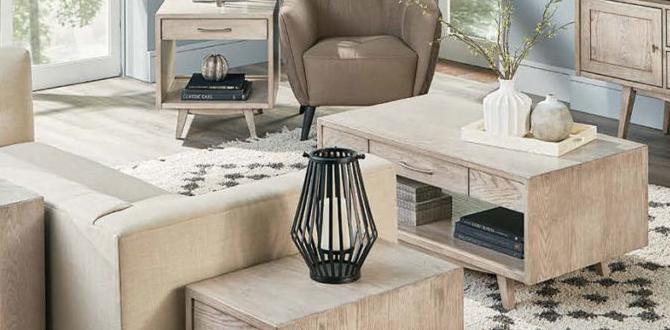Quick Summary:
Choosing the right indoor cushions for wicker furniture enhances comfort, style, and longevity. Look for plush, durable fabrics that complement your decor and fit your wicker pieces perfectly for a cozy, inviting space.
Wicker furniture brings a lovely natural charm indoors, but it can feel a bit stiff and unwelcoming without the right touch. That’s where cushions come in! Finding the perfect indoor cushions for your wicker pieces might seem tricky, but it’s actually quite simple when you know what to look for. We’ll guide you through making your wicker furniture the coziest spot in your home.
This guide will help you choose cushions that feel as good as they look, stand the test of time, and even add a pop of personality to your living space. Let’s get started on transforming your wicker furniture!
Why Indoor Cushions Are a Must for Wicker Furniture
Wicker furniture, whether made from rattan, bamboo, or synthetic materials, has a beautiful, airy aesthetic. However, the woven nature can mean less built-in comfort compared to upholstered pieces. Cushions transform hard, potentially pokey surfaces into inviting havens for relaxation.
Beyond pure comfort, cushions are your secret weapon for expressing style. They offer a fantastic opportunity to inject color, pattern, and texture into your room, tying your furniture into the overall decor scheme. Think of them as the stylish outfit for your furniture!
Choosing the Right Fabric for Indoor Wicker Cushions
The fabric you choose is super important for both looks and how long your cushions will last. For indoor use, you have a bit more flexibility than with outdoor furniture, but durability and ease of cleaning are still key.
Durable & Family-Friendly Fabrics
If you’ve got kids or pets, or just want cushions that can handle a lot of use, these are your go-to options:
- Cotton Blends: Offer a good balance of comfort and durability. Look for heavier weight blends that are less likely to wrinkle.
- Polyester: A workhorse fabric known for its strength and resistance to fading and wrinkling. It’s also surprisingly soft.
- Olefin (Polypropylene): This synthetic fiber is incredibly durable, stain-resistant, and easy to clean. It’s often used outdoors but is excellent indoors too, especially for high-traffic areas.
- Performance Fabrics: Brands like Sunbrella and Crypton offer fabrics specifically designed to resist stains, spills, mold, and fading, making them ideal for busy homes. They are a bit pricier but offer fantastic longevity.
Luxurious & Stylish Fabrics
For a more elegant feel, consider these options:
- Velvet: Adds a touch of luxury and softness. It’s best suited for areas with less heavy use unless it’s a performance velvet.
- Linen Blends: Offer a sophisticated, natural look. They can be prone to wrinkling, so a blend with polyester or rayon can improve durability.
- Outdoor-Rated Fabrics (Indoors): Many high-quality outdoor fabrics are now quite stylish and offer excellent fade and stain resistance, making them a practical choice for any sunny room.
What to Avoid (Mostly!)
While some delicate fabrics can work in very low-traffic areas, you might want to steer clear of:
- Pure Silk: Beautiful but very delicate and prone to staining and damage.
- Sheer or very thin fabrics: They won’t offer much in terms of comfort or durability for seating.
Understanding Cushion Fill: Comfort & Shape Retention
The inside of your cushion matters just as much as the outside! The filling impacts comfort, how well the cushion holds its shape, and its overall lifespan.
Common Cushion Fill Types
Here’s a breakdown of popular filling materials:
- Polyester Fiberfill: This is a very common and budget-friendly option. It’s soft and provides good cushioning. However, it can compress over time, leading to a less supportive cushion.
- Foam (Polyurethane Foam): Offers firmer support and holds its shape better than fiberfill. High-density foam is best for longevity and comfort on harder wicker.
- Foam Wrapped in Dacron/Polyester Fiber: This is a fantastic combination! The foam provides structure and support, while the fiber wrapping creates a softer, more plush surface. It’s a popular choice for a reason.
- Down/Feather Blends: Offer the ultimate in luxurious softness. They are very comfortable but require regular fluffing to maintain shape and can be more expensive.
Choosing the Right Fill for Your Wicker Furniture
Consider how you’ll use the furniture. For accent pieces or chairs that aren’t used daily, softer fills like fiberfill or down blends might be perfect. For primary seating like a wicker sofa or armchair, a firmer foam core, perhaps wrapped in fiber, will offer the best support and last longer.
Check out The Spruce for more on choosing the right cushion fill for your needs:
https://www.thespruce.com/best-couch-cushion-fillings-4151096
What Type of Wicker Furniture Are You Cushioning?
The shape and purpose of your wicker furniture will dictate the kind of cushions you need. Are we talking about a grand wicker sofa, a cozy armchair, or a charming wicker Etagere (a type of shelf unit often made of woven materials)? Let’s look at common types:
Wicker Chairs (Armchairs & Side Chairs)
These are perhaps the most common. You’ll typically need:
- Seat Cushions: These are the most essential. Measure carefully to ensure a snug fit.
- Back Cushions: Often slightly thinner or designed to hug the wicker frame.
- Throw Pillows: For added comfort, style, and a layered look.
Wicker Sofas & Loveseats
Similar to chairs, but larger. Look for:
- Seat Cushions: Often one long cushion or segmented smaller ones.
- Back Cushions: Again, can be one long piece or multiple.
- Armrest Covers: These can protect the wicker arms and add a touch of elegance.
- Accent Pillows: To complete the look.
Wicker Ottomans & Footstools
These are relatively simple.
- Cushion Tops: Designed to fit the ottoman’s dimensions, providing a comfortable place to rest your feet or an extra seat.
Wicker Benches
Benches can vary greatly in size and style. You might need:
- Long Seat Cushions: Often custom-made or found in specific lengths to fit.
- Tufted Cushions: Can add a classic look and extra comfort.
Measuring for the Perfect Fit
This is a crucial step to ensure your cushions look balanced and feel comfortable. Awkwardly sized cushions can detract from the beauty of your wicker furniture.
Here’s how to measure:
- For Seat Cushions:
- Width: Measure the widest part of the seat from left to right.
- Depth: Measure from the front edge of the seat straight back to where the seat meets the backrest.
- Thickness (Height): Measure from the bottom of the wicker seat frame to its top. A typical thickness is 3-5 inches, but you can go thicker for more plushness.
- For Back Cushions:
- Width: Measure the width of the backrest frame.
- Height: Measure from the bottom of the backrest frame (where it meets the seat) to the top of the backrest.
- Thickness: Usually thinner than seat cushions, perhaps 2-4 inches.
Pro Tip: If you’re buying custom cushions, it’s a good idea to add about half an inch to your measurements for a slight gusset or to allow the cushion to fit snugly without being too tight.
DIY vs. Buying Pre-Made Cushions
You have two main paths to getting your cushions: buying them ready-made or diving into a DIY project. Both have their pros and cons.
Here’s a quick comparison:
| Option | Pros | Cons |
|---|---|---|
| Buying Pre-Made |
|
|
| DIY Cushions |
|
|
Tips for DIY Cushion Making
If you’re feeling ambitious, here are some pointers:
- Start Simple: Begin with a basic rectangular seat cushion.
- Use a Pattern: Trace your existing cushions or create a paper pattern from your measurements.
- Choose the Right Fabric: Opt for upholstery fabric that’s suitable for your needs.
- Zipper or Ties: A zipper makes it easy to remove the cover for washing. Ties are great for securing cushions to the furniture.
- Generous Seams: Always add an extra inch or so for seam allowance, especially if you’re new to sewing.
- Reinforce Corners: These are high-stress areas.
Styling Your Indoor Wicker Furniture with Cushions
Now for the fun part: making it look amazing! Cushions are your style palette.
Color and Pattern Coordination
Think about your existing room decor. Are you aiming for a cohesive, neutral look or a bold statement?
- Neutrals: Beige, cream, grey, and taupe offer a timeless and calming feel. They let the texture of the wicker shine.
- Bold Colors: Jewel tones like emerald green, sapphire blue, or ruby red can add drama and sophistication. Brights like coral, turquoise, or sunny yellow can liven up a space.
- Patterns: Florals can add a charming, cottage-like feel. Geometric patterns can lend a modern touch. Stripes are classic and versatile. Consider a mix of patterns by pairing a large-scale print with a smaller one, or a solid neutral.
Layering with Throw Pillows
Don’t stop at just the seat and back cushions! Add a few throw pillows for extra comfort and visual interest. Mix and match sizes, shapes, and textures. A large bolster pillow can add lumbar support, while smaller square pillows add color pops.
Fabric Textures
Texture plays a huge role in how a room feels. Contrasting the smooth weave of the wicker with different fabric textures can be very appealing.
- Smooth: Cotton, linen, polyester.
- Textured: Velvet, chenille, chunky weaves, faux fur.
- Embellished: Tassels, piping, embroidery.
Caring for Your Indoor Wicker Cushions
To keep your cushions looking and feeling their best, a little regular care goes a long way.
Spot Cleaning
Most fabrics can handle minor spills. Blot spills immediately with a clean, dry cloth. For tougher stains, use a mild soap and water solution. Always test cleaning solutions on an inconspicuous area first.
Deep Cleaning
Check the care label on your cushions. Some covers are removable and machine washable (on a gentle cycle, cold water). Others may require professional dry cleaning. Foam inserts can sometimes be spot cleaned, but avoid saturating them.
If your cushions don’t have removable covers, you can use a fabric upholstery cleaner according to the manufacturer’s instructions. For more difficult issues, consult resources like the U.S. Environmental Protection Agency for guidance on safer cleaning practices.
Protection Against Sun and Wear
Even indoors, direct sunlight can cause fabrics to fade over time. If your wicker furniture is placed near a sunny window, consider using curtains or blinds to block harsh rays when not in use. Rotating cushions periodically can also help ensure even wear.
FAQ: Your Wicker Cushion Questions Answered
Q1: Can I use outdoor cushions indoors?
A1: Yes, you absolutely can! Outdoor cushion fabrics are often designed to be durable, fade-resistant, and stain-resistant, which can be a real advantage even for indoor use, especially in sunny rooms or homes with pets and kids. Just ensure the style fits your indoor decor.
Q2: How thick should my wicker cushions be?
A2: The thickness depends on your preference and the furniture. For seat cushions, 3-5 inches is common for good support. Back cushions are often thinner, around 2-4 inches. If you want a super plush feel, you can go thicker, but ensure it doesn’t overpower the furniture’s scale.
Q3: My wicker furniture is an odd shape. Can I still get cushions for it?
A3: Definitely! If standard-sized cushions won’t fit, custom-made cushions are your best bet. Many online retailers and local upholstery shops specialize in creating cushions to your exact specifications. DIY is also a great option here.
Q4: How do I prevent my cushions from sliding off the wicker?
A4: Look for cushions with ties that can be secured to the furniture’s frame. Alternatively, you can use non-slip rug pads or a specialized cushion gripper pad between the wicker and the cushion to add friction and keep them in place.
Q5: What’s the best way to clean wicker furniture itself?
A5: For natural wicker, gently dust with a soft brush or vacuum attachment. For deeper cleaning, use a damp cloth with mild soap and water for the frame, and dry thoroughly afterward. Avoid soaking natural wicker, as it can weaken the material. Synthetic wicker is generally more forgiving and can often be cleaned with soap and water.
Q6: Are there eco-friendly cushion filling options?
A6: Yes! Look for organic cotton or natural latex foam fills. Recycled polyester fiberfill is also a more sustainable choice than virgin polyester. Some manufacturers are also exploring innovative sustainable fillings.
Conclusion
Adding indoor cushions to your wicker furniture is one of the simplest yet most impactful ways to enhance comfort, functionality, and style. By carefully considering the fabric, fill, size, and your specific furniture type, you can create a cozy, inviting oasis that perfectly complements your home’s aesthetic.
Whether you choose to buy ready-made, go the custom route, or embark on a DIY project, the result will be furniture that’s not only beautiful but also a joy to relax in. Happy decorating and happy lounging!





